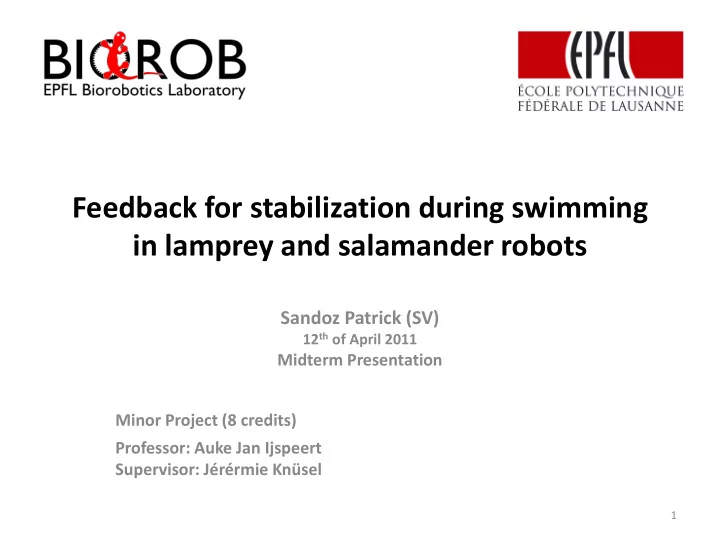

Feedback for stabilization during swimming in lamprey and salamander robots Sandoz Patrick (SV) 12 th of April 2011 Midterm Presentation Minor Project (8 credits) Professor: Auke Jan Ijspeert Supervisor: Jérérmie Knüsel 1
Introduction • Postural stabilization method against Roll tilt Pitch tilt • Bio-imitated response based on the vestibular system “Any deviation from this orientation evokes a corrective motor response to restore the initial orientation. This response may include a lateral flexion of the ventrally deviated tail, a lateral deviation of the dorsal fin and a body twisting ( … ) Postural corrective reflexes in the lamprey are driven by vestibular inputs. “ A.K. Kozlov et al, Modeling postural control in the lamprey (2001) • Feedback sensor Accelerometer (MMA8453Q) 2
Biological stabilization • Vestibular system Vestibular system is also taking part to lateral body controls E. Pavlova, Vestibular control of body orientation in lamprey, Nobel Institute for Neurophysiology, Department of Neuroscience, Karolinska Institute, Stockholm, Sweden, 2004 3
Integrating body control in CPG network Auke Jan Ijspeert et al., From Swimming to Walking with a Salamander Robot Driven by a Spinal Cord Model, Science 315, 1416 (2007) 4
Objectives • Stabilization during swimming (2 parallel prospecting) Test and Design the Implement Sensor: calibrate controller in the robot Simulation in webots Movie Profiles Response: analysis generation Test on the robot 6
Robot improvements • Asymmetrical caudal fin • Limbs • Weight for optimal density • Swimsuit (thera-band) • Asymmetrical / off-center movements 7
First tests in small pool • Moving legs is more relevant than fixing the position • Ailerons rotation allows: • to plunge (fin up) • to surface (fin down) • Legs and fins slow down swimming and act only little (in real life, salamander doesn’t use its legs during swimming) 8
Webots simulation • Again legs and fins slow down swimming and act little (and here also ailerons) • Asymmetrical tail oscillation stabilizes against rolling 9
Webots simulation: an example Failed case Stabilized case 10
Initial perturbation ( π /4) situation followed by robot rolling (straight tail) Initial perturbation ( π /4) situation followed by robot stabilization (perpendicular tail) 11
Accelerometer in the controller Example: Initial perturbation ( π /4) situation Straight tail robot rolls while asymmetrical tail robot stabilizes 12
Retained body responses To rolling: • Asymmetrical movements of tail To pitch tilt: • Ailerons correction 13
Next steps Test and Design the Implement Sensor: calibrate controller in the robot Body Response Big pool tests 14
Questions ? References • Auke Jan Ijspeert et al., From Swimming to Walking with a Salamander Robot Driven by a Spinal Cord Model , Science 315, 1416 (2007) • Auke Jan Ijspeert et al., Supporting Online Material for From Swimming to Walking with a Salamander Robot Driven by a Spinal Cord Model, (2007) • A.K. Kozlov et al, Modeling postural control in the lamprey , Biol. Cybern. 84, 323-330 (2001) • Elena Pavlova, Vestibular control of body orientation in lamprey , Nobel Institute for Neurophysiology, Department of Neuroscience, Karolinska Institute, Stockholm, Sweden (2004) • T. G. Deliagina, Vestibular compensation in lampreys: impairment and recovery of equilibrium control during locomotion , The Journal of Experimental Biology 200, 1459 – 1471 (1997) • A. Karayannidou, Responses of Reticulospinal Neurons in the Lamprey to Lateral Turns , J Neurophysiol 97: 512 – 521 (2007) • C. Georgiades, AQUA: an aquatic walking robot , informing paper (2007) • Ayers, J., Wilbur, C., Olcott, C. (2000) Lamprey Robots . In: Proceedings of the International Symposium on Aqua Biomechanisms, T. Wu and N, Kato, Tokai University • Makoto Mori and Shigeo Hirose, Locomotion of 3D Snake-Like Robots – Shifting and Rolling Control of Active Cord Mechanism ACM-R3 , Journal of Robotics and Mechatronics Vol.18 No.5, (2006) • Hiroya Yamada, Makoto Mori and Shigeo Hirose, Stabilization of the head of an undulating snake-like robot , Proceedings of the 2007 IEEE/RSJ International Conference on Intelligent Robots and Systems, San Diego, CA, USA, Oct 29 - Nov 2, 2007 • K. Seo et al., CPG-based control of a turtle-like underwater vehicle , Auton Robot 28: 247 – 269 (2010) 15
Recommend
More recommend